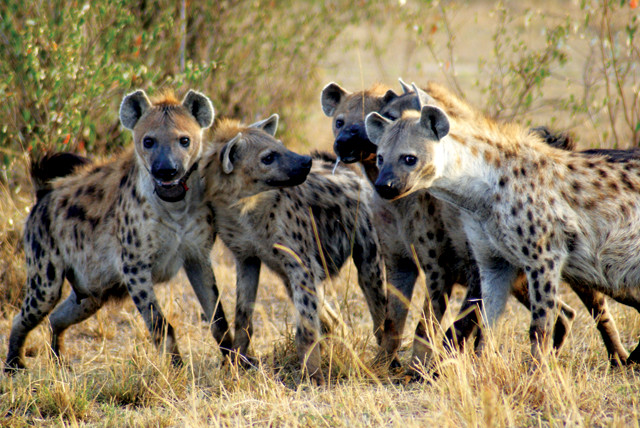
by Mary Caperton Morton Tuesday, May 5, 2015

Studying the behavior and social structure of living carnivores, such as spotted hyenas, might shed light on whether early humans led cooperative lives. Credit: David S. Green.
Traditionally, anthropologists thought that hunting played a huge role in the lives of early humans, perhaps because of the prominence of stone tools in the fossil record. But today, most researchers recognize that hominids must have exploited a wide range of resources, and were probably not exclusively carnivores.
“In the past few years, there has been a shift away from the model of early humans as hunters, but there’s still a lot we can learn by studying our ancestors through the lens of modern-day carnivores,” says Jenn Smith, a zoologist at Mills College in Oakland, Calif., who studies spotted hyenas in Kenya.
Hyenas are highly social animals that live in large packs composed of many families that all work together to raise their young. “Comparisons between hyenas and early humans are interesting for a number of reasons. They both evolved in a similar habitat in Africa, coping with similar environmental challenges,” Smith says. “Hyenas also have a very flexible social system — similar to a lot of primates — called a fission-fusion society.”
In a fission-fusion society, members of a family group commonly separate during the day, with some individuals in charge of hunting and others in charge of caring for the young. When the members reunite, they do so with minimal conflict. “This kind of structure allows for a lot of flexibility and a very efficient division of labor, while maintaining social relationships between the groups,” she says.
“Early humans may have lived in fission-fusion societies. The most successful mammalian carnivores are typically cooperative breeders, with many members of the group sharing responsibility for the young,” Smith says. A number of characteristics point to early humans being cooperative breeders, including limited sexual dimorphism — physical differences between males and females — and higher population densities clustered around resource-rich areas.
“The bodies of social carnivores differ from more solitary carnivores,” says Susan Antón, an anthropologist at New York University. “A lot of characteristics we see, like increased brain size relative to body size [in more social animals], seem to reflect the social organization of the species,” she says.
“By surveying different social factors that favor cooperation, we can relate those to behaviors such as reproduction, diet type and home range, which anthropologists are very interested in learning about [in relation to] our human ancestors,” Smith says. These kinds of questions may reveal what factors could have led to the degree of cooperation that we see in human populations.
“A lot of the questions we have about sociality and how cooperative early Homo was are only going to be answerable through this kind of integrated approach,” Antón says. “Until recently, nobody was even asking these kinds of questions.”
© 2008-2021. All rights reserved. Any copying, redistribution or retransmission of any of the contents of this service without the expressed written permission of the American Geosciences Institute is expressly prohibited. Click here for all copyright requests.